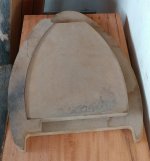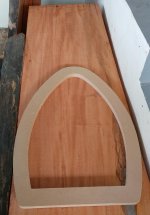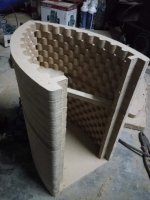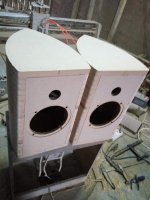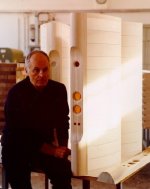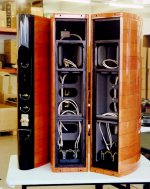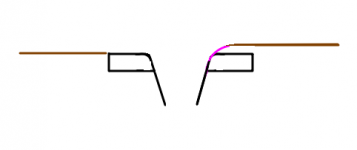The Plyboo stranded we got only came in 4 x 6. I do not recommend using the vertical grain (most commonly used, the 1st stuff we used — a free half sheet, resultin gin the speaker si posted above), and definitly not the horizontal grain.
We did not ever try the Cali Fossilized which i believe is their stranded version, It is available in 4x8 sheets and at the time we checked more affordable.
And i strongly suspect that bamboo solid “boards” are not as good as the best plys (likely higher variability in quality as well across what is available).
We abandoned the available 5x5 BB as the quality went way downhill over time, and switched to urphyPy from Oregon. Pricier in cost, but less wasteful and much less effort to deal with variable material thickness (even across a single board)
dave
We did not ever try the Cali Fossilized which i believe is their stranded version, It is available in 4x8 sheets and at the time we checked more affordable.
And i strongly suspect that bamboo solid “boards” are not as good as the best plys (likely higher variability in quality as well across what is available).
We abandoned the available 5x5 BB as the quality went way downhill over time, and switched to urphyPy from Oregon. Pricier in cost, but less wasteful and much less effort to deal with variable material thickness (even across a single board)
dave
Two very different loudspeakers with quite different choices of compromises.
FHXL is about an order of magnitude cheaper and the FR means there is no XO to get in the way. It will do some things better than Elsinore and visa vesa.
I do have something tickling my mind that builds on some of the ideas that Elsinore brings, but makes some compromises in the direction of a good FR speaker.
dave
indeed Elsinore & FHXL are 2 different types, but what about Halycon vs FHXL? additional NRX drivers on Halycon gives 10p less load on bass area and let it work 300Hz above and it's 1st order crossover too like Elsinore.
I woud fully agree that a good WAW can be very good. I have been listening to a pair with Alpair 7.3eN and a pair of Alapir 12pWeN per box. XO lower than the Halcyon, but also a pair of 6.5” driver sin a TL. Performance is superb. Net no loss of the FR magic, yet with serious bass capability. Releiving the FR of LF lends to better mid/top performance for the FR. Whether there is sufficient top for some people would be a question, but it allows for a cross-over in a much more benign spot (250 Hz) where 1/4 wavelength at XO is greater than the centre-to-centre of the drivers. A7.3 is a better driver for this purpose than the A10 (either one).
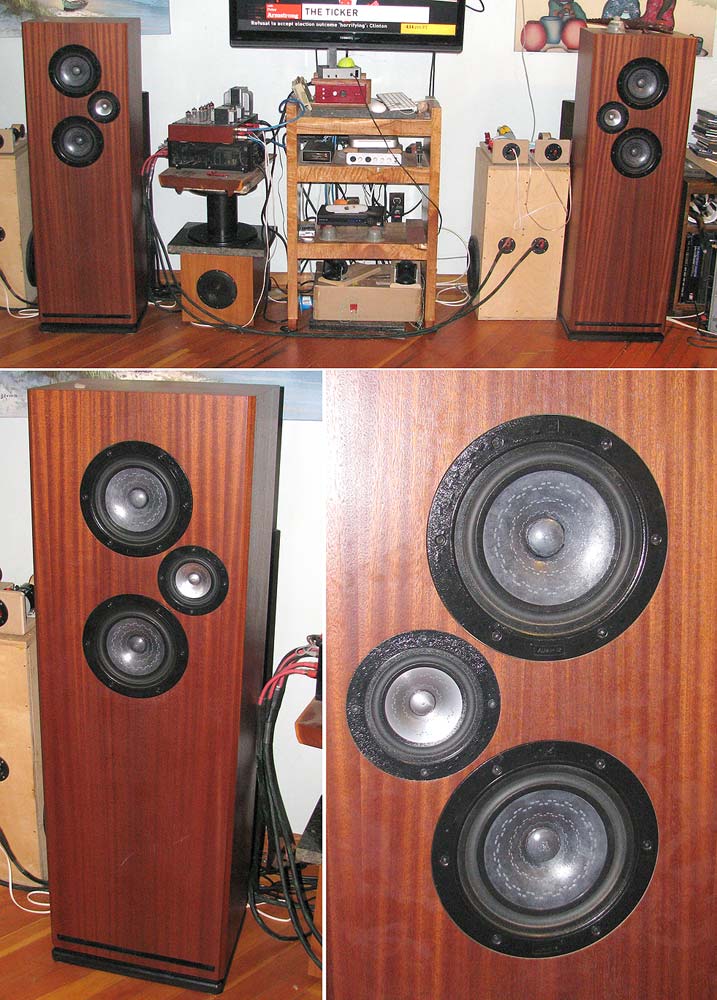
The passive XO is higher than i would consider in the Halcyon, one of the reasons i helped Alan with the wiring needed to try biamping (when the designer said it could not be done).
We are getting sidetracked thou here.
dave

The passive XO is higher than i would consider in the Halcyon, one of the reasons i helped Alan with the wiring needed to try biamping (when the designer said it could not be done).
We are getting sidetracked thou here.
dave
Love to see a suitable cabinet re-design based on 3/4" material everywhere that would keep Joe's goals intact.
Not sure if anyone will find this useful, but my sketchup of the original in mm and another slightly massaged to work with inch...
Attachments
Love to see a suitable cabinet re-design based on 3/4" material everywhere that would keep Joe's goals intact.
it should be fairly easy and is on my plate, ut a low priority.
dave
Yes, I will certainly ask Bob Berner if he wants to make a flat pack, if I decide to move on this. Right now I’m just trying to find out what kits for the Elsinore Project, if any, are currently in existence for US customers. Both electronic/driver and cabinet. Neither Madisound, Meniscus, nor DIYsoundGroup have anything...
I would love them to show interest and as the Elsinore Project has gradually gotten momentum, then maybe if enough makes enquiries to them, maybe a kit could happen buy for example Madisound? I am not the pushy kind, so if that is to happen, it has to come from elsewhere. Besides, this is hardly a source of income to me, this is more about the technology.
The good news is that a 3-Way active system prototype is being made by a known manufacturer where the designer has been a friend for thirty years. It is being developed hopefully over the next five months and to be demonstrated at the autumn London show (it was postponed from June), based on the technology used in the Elsinores, where the equalised impedance, flat near zero degrees current phase angle, these makes it possible to design an all-active current driver speaker system - and that means even means current drive of the bass - something that others say is not possible. But guess what, the Elsinores as you guys are building it as per spec, you can already do that! It can be driven by both voltage (conventional) and current (pretty much unheard of) even now. The high output impedance of current mode is canceled out. The amp behaves as it has no output impedance.
The Elsinores and the way they work is all about this, how the current of the amplifier is treated. More awareness of this is growing and it will affect how speakers in the future are designed - the interest is growing.
Making Elsinores available as a kit, especially in the US, I believe would accelerate that process.
A7.3 is a better driver for this purpose than the A10 (either one).
dave
it's just that i still don't decide yet on what should i build with 10p, once i considered to sell it (also with AN 8 classic) to reduce my inventory but i will keep it for a while and decide later after completing Elsinore
i just find my previously ordered template have been exposed to moisture but still in good shape.
when i draw it to my lumber, the old template has higher output result where 1 lumber can give 10 layers compared to new one which will only give me 4 layers. the different is that i only need extra on gluing and make front/back baffle
my friend has built smaller bookshelf and it looks good. i think i will go on my older template SonusFaber style to reduce wood waste
Attachments
When using real wood I think I would line up the grain with the forward part of the cabinet wall (the curved pieces you have traced). In addition, the "thumb" that sits behind the baffle edge is susceptible to snapping along the grain, and should be reinforced in shape.
I would love them to show interest and as the Elsinore Project has gradually gotten momentum, then maybe if enough makes enquiries to them, maybe a kit could happen buy for example Madisound? I am not the pushy kind, so if that is to happen, it has to come from elsewhere. Besides, this is hardly a source of income to me, this is more about the technology.
The good news is that a 3-Way active system prototype is being made by a known manufacturer where the designer has been a friend for thirty years. It is being developed hopefully over the next five months and to be demonstrated at the autumn London show (it was postponed from June), based on the technology used in the Elsinores, where the equalised impedance, flat near zero degrees current phase angle, these makes it possible to design an all-active current driver speaker system - and that means even means current drive of the bass - something that others say is not possible. But guess what, the Elsinores as you guys are building it as per spec, you can already do that! It can be driven by both voltage (conventional) and current (pretty much unheard of) even now. The high output impedance of current mode is canceled out. The amp behaves as it has no output impedance.
The Elsinores and the way they work is all about this, how the current of the amplifier is treated. More awareness of this is growing and it will affect how speakers in the future are designed - the interest is growing.
Making Elsinores available as a kit, especially in the US, I believe would accelerate that process.
I did contact Bob and he's got time (don't we all) so he is going to draw up the flat pack for his CNC and post it on his website so folks can see the cost and shipping involved. He's unable to actually work in his shop due to the lockdown but sounds like he thinks its a worthwhile project to at least get a plan drawn up. I'm going to hold off on assembly until I see what how his kit might work.
And I agree...a kit would make things much easier for non-woodworkers to participate.
Last edited:
I am working on drawing up the Elsinore as we type. It appears to me that all of the ply is 25mm thick except for the front baffle which is 18mm. Is there a reason for this? Any problem with making the front baffle 25mm as well?
I am surprised to see that the tweeter needs a stiffening panel behind it. I'll be the first to admit that I am no speaker designer, but why wold a tweeter need additional stiffening? There doesnt seem to be a lot of mass there or a lot of movement/travel (distance) in a tweeter. Plus it is mounted to an aluminum wave guide. This should help stiffen it, doesn't it?
I am surprised to see that the tweeter needs a stiffening panel behind it. I'll be the first to admit that I am no speaker designer, but why wold a tweeter need additional stiffening? There doesnt seem to be a lot of mass there or a lot of movement/travel (distance) in a tweeter. Plus it is mounted to an aluminum wave guide. This should help stiffen it, doesn't it?
I am working on drawing up the Elsinore as we type. It appears to me that all of the ply is 25mm thick except for the front baffle which is 18mm. Is there a reason for this? Any problem with making the front baffle 25mm as well?
I am surprised to see that the tweeter needs a stiffening panel behind it. I'll be the first to admit that I am no speaker designer, but why wold a tweeter need additional stiffening? There doesnt seem to be a lot of mass there or a lot of movement/travel (distance) in a tweeter. Plus it is mounted to an aluminum wave guide. This should help stiffen it, doesn't it?
Hopefully Joe will jump in here and provide some insight.
The passive XO is higher than i would consider in the Halcyon, one of the reasons i helped Alan with the wiring needed to try biamping (when the designer said it could not be done).
Dave, thanks again for your help with the crossover BI-amp solution. I hope to get back to work on it this weekend.
Just to clarify, the designer, Curt Campbell, didn’t say it couldn’t be done. It was one of the guys at Madisound. He was pretty insistent, even after I showed him your diagram.
Hopefully Joe will jump in here and provide some insight.
The Waveguide is made to suit 18mm, you want it to be reasonably flush and it won't be with 25mm. No great insight, just how the numbers match up.
The Waveguide is made to suit 18mm, you want it to be reasonably flush and it won't be with 25mm. No great insight, just how the numbers match up.
Can't the tweeter be moved forward by 7mm To bring it flush? Is this so the drivers are all in the same plane? Forgive my lack of speker design knowledge, I am still learning.
Why the extra bracing on the back of the tweeter?
Also, are the cutouts on the back for terminal plates critical? Meaing does it matter what plates or cups someone uses on this speaker, or can they choose thier own?
And for Kim, miters are doable but I am not crazy about using them in this situation. They are more labor intensive to get right and should be reinforced somehow. I am looking into this for someone else on another enclosure and hope to find a simple way to make the joint on the CNC.
Can't the tweeter be moved forward by 7mm To bring it flush? Is this so the drivers are all in the same plane? Forgive my lack of speker design knowledge, I am still learning.
Why the extra bracing on the back of the tweeter?
Also, are the cutouts on the back for terminal plates critical? Meaing does it matter what plates or cups someone uses on this speaker, or can they choose thier own?
And for Kim, miters are doable but I am not crazy about using them in this situation. They are more labor intensive to get right and should be reinforced somehow. I am looking into this for someone else on another enclosure and hope to find a simple way to make the joint on the CNC.
Seems like you could recess the front baffle 18mm to house the Joe's waveguides. You'd have to provide another recess for the tweeter...might be getting that front baffle pretty thin but it would be reinforced by the sub-front baffle. If that makes sense.
There's a good explanation on the tweeter setup buried in this thread and maybe on Joe's website that explains the goals of the extra tweeter bracing.
I figured the miters would make things more difficult. On the cutouts, I think those are Joe's recommendations but obviously not everyone is using that set up. I'm going to use Nuetrik Speakons so I'd think you'd leave the cutouts to the client.
Last edited:
Tweeter waveguide
After much searching I found photos of the tweeter with the waveguide attached. From what I read of the assembly instructions, it sounds like the tweeter gets mounted to the secondary baffle then the wave guide gets attached to the tweeter and the baffle. Could we just flush mount the waveguide/tweeter assembly to the front baffle? Does it matter if there is a gap of 7mm between the back of the tweeter and the secondary baffle?
I've priced and sourced 25mm BB ply and it is readily available.
Ok, unless the tweeter needs to be in some sort of spacial (planar) relationship to the other drivers, I cant see why using 25mm ply for the baffle would be anydifferent than the current setup with the 18mm ply. Make the correctly sized hole for the body of the tweeter, and then the lmounting flange, then just a proper rebate for the wave guide to sit flush.
After much searching I found photos of the tweeter with the waveguide attached. From what I read of the assembly instructions, it sounds like the tweeter gets mounted to the secondary baffle then the wave guide gets attached to the tweeter and the baffle. Could we just flush mount the waveguide/tweeter assembly to the front baffle? Does it matter if there is a gap of 7mm between the back of the tweeter and the secondary baffle?
I've priced and sourced 25mm BB ply and it is readily available.
Ok, unless the tweeter needs to be in some sort of spacial (planar) relationship to the other drivers, I cant see why using 25mm ply for the baffle would be anydifferent than the current setup with the 18mm ply. Make the correctly sized hole for the body of the tweeter, and then the lmounting flange, then just a proper rebate for the wave guide to sit flush.
Last edited:
After much searching I found photos of the tweeter with the waveguide attached. From what I read of the assembly instructions, it sounds like the tweeter gets mounted to the secondary baffle then the wave guide gets attached to the tweeter and the baffle. Could we just flush mount the waveguide/tweeter assembly to the front baffle? Does it matter if there is a gap of 7mm between the back of the tweeter and the secondary baffle?
I've priced and sourced 25mm BB ply and it is readily available.
Ok, unless the tweeter needs to be in some sort of spacial (planar) relationship to the other drivers, I cant see why using 25mm ply for the baffle would be anydifferent than the current setup with the 18mm ply. Make the correctly sized hole for the body of the tweeter, and then the lmounting flange, then just a proper rebate for the wave guide to sit flush.
IIRC the waveguide and tweeter are joined using bolts supplied by Joe, and then both are mounted to the sub-front baffle. The hole in the front baffle is just the width of the waveguide. But can't see why you couldn't do it your way. Is there a pressing need on the 25mm front baffle or is it just simpler to have it all one thickness?
BTW...its been almost 12 hours....where are the plans already.
Last edited:
- Home
- Loudspeakers
- Multi-Way
- The "Elsinore Project" Thread
